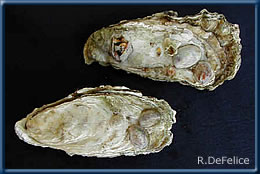

Anomia nobilis

Crassostrea virginica

Chama macerophylla

Crucibulum spinosum
Crassostrea virginica
 American
Oyster
American
Oyster
Virginia Oyster, Atlantic Oyster,
Eastern Oyster, Common Oyster
Phylum Mollusca
Class Bivalvia
Family Ostreidae
Description
Oysters are sedentary with their lower valve firmly cemented to hard objects.
Their flattened, distorted shells are extremely variable in shape. The
shells of Crassostrea virginica are typically
broadly oval and thick, and grow to about 10-15 cm in length. The lower
valve is convex and upper valve flat, usually with concentric ridges and
lines. Exterior color is dirty white to gray. The interior is bright white
with a deep purple or red-brown muscle scar (from Kay 1979).
Habitat
Oysters favor estuaries and embayments with low salinities and are intolerant
of prolonged exposure to fresh water or marine conditions. They are found
in shallow water of tidal to subtidal depth of fairly constant turbidity
and salinity, but are able to withstand a wide range of temperatures.
Oysters usually colonize in beds. Competition for space is an important
source of mortality. Uncrowded, oysters can live to be 20 years old.
Distribution
Hawaiian Islands
Throughout the main islands in estuarine areas
Native Range
Gulf of St. Lawrence to Brazil
Present Distribution
Gulf of St. Lawrence to Brazil, British Columbia, and Hawaiian Islands
Mechanism of Introduction
Intentional, for commercial oyster fishery. First plantings in 1866 in
Pearl Harbor.
Impact
Fouling organism. Ecological impact in Hawaiian Islands unstudied. Before
a die-off in the early 1970s, these oyster formed extensive dense beds
in the estuarine areas of Pearl Harbor which undoubtedly affected the
native benthic communities there.
Ecology
Feeding
Bivalves are suspension feeders. Water is moved through an incurrent siphon
into the mantle cavity by cilia on the ctenidia (gills). Water passes
over the ctenidia, food particles are extracted by the cilia, and water
is expelled through an exhalent siphon.
Reproduction
These bivalves are gonochoristic (having separate male and female individuals),
fertilization is external, and the developing larvae (veliger) settle
to the bottom after a time in the plankton. The first spawning usually
occurs when the oyster is around two years of age.
Remarks
Crassostrea virginica remains established
in Pearl Harbor (Coles et al., 1999), as a result of what is widely regarded
as large plantings made in 1866. The history of plantings of this oyster
in Hawaii are given by Kay (1979), and it is reported that there were
150,000 square yards of C. virginica beds
in Pearl Harbor, with an estimated 35 million oysters.
In the early 1970s, C. virginica is recorded
as having suffered extensive mortalities in Pearl Harbor. In July, 1972
it was reported that 34 million oysters were killed in West Loch, Pearl
Harbor (Anonymous 1972). Three reasons for this mortality have been suggested
by various authors; disease, pollution, and sedimentation.
Crassostrea virginica apparently recovered
over the next quarter century and is now common in West Loch, Pearl Harbor.
Whether the population now in Pearl Harbor resulted from the original
1866 planting or from the later plantings in the 1920s is not known. Also
now present in Pearl Harbor is the introduced Australian oyster Saccostrea
cucullata.
References
Anonymous. 1972. Pearl Harbor oyster kill! Hawaiian Shell News. 20(8):
2.
Coles, S.L., R.C. DeFelice, L.G. Eldredge and J.T. Carlton. 1999. Historical
and recent introductions of nonindigenous marine species into Pearl Harbor,
Oahu, Hawaiian Islands. Marine Biology. 135: 147-158.
Kay, E.A. 1979. Hawaiian Marine Shells. Reef and Shore Fauna of Hawaii,
Section 4: Mollusca. B.P. Bishop Mus. Spec. Pub. 64(4), 653 pp.
© 2002 Hawaii Biological Survey, Bishop Museum
contact